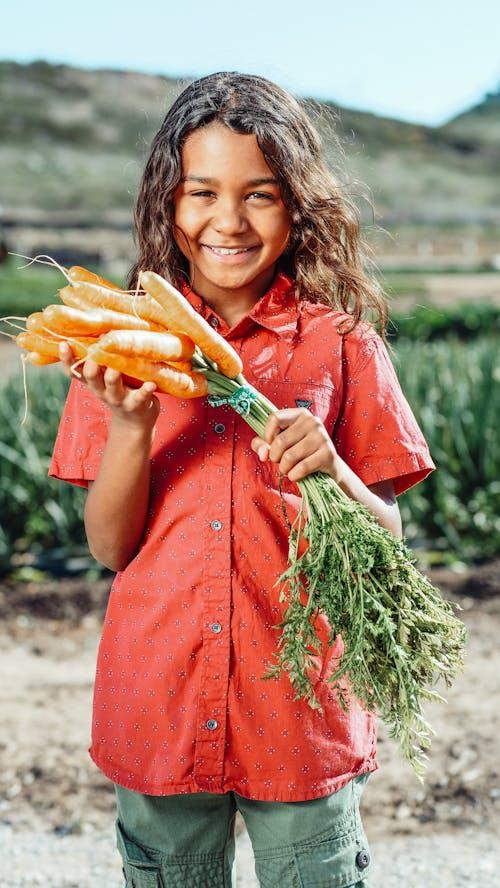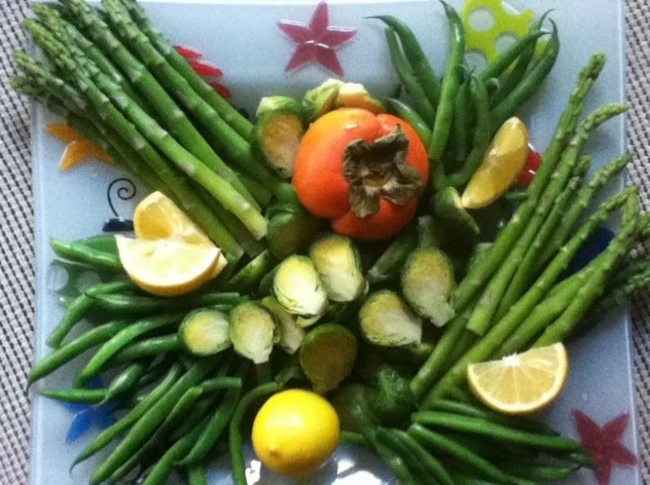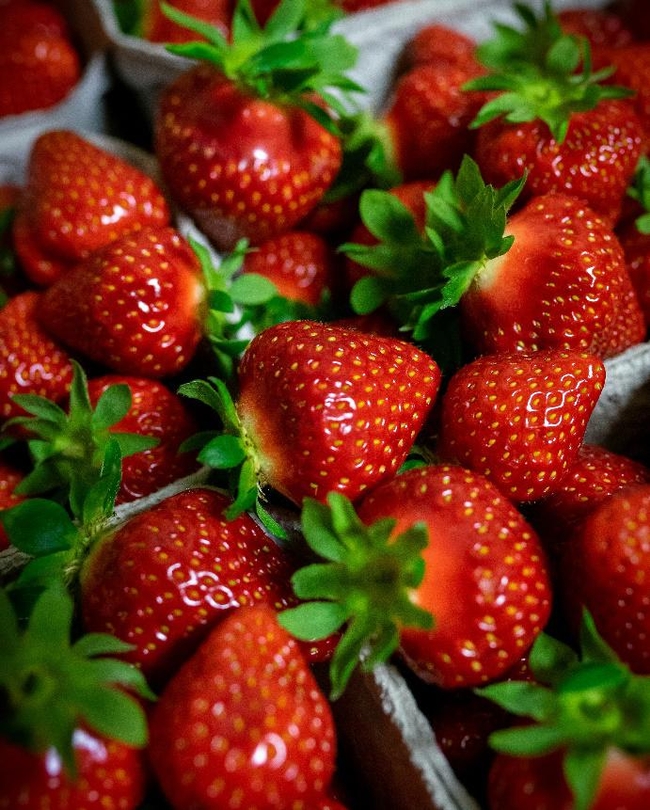Yep, we're talking about vegetables and fruits and the joy of homegrown food. Read on about vegetarian eating, getting the kids on the veggie train, a bit of food history, and recipes—some tried and deemed true by kids themselves.

Imagine a little guy, sitting on a small Adirondack chair and smiling with pride at the head of broccoli in his hands. He was involved in the process of growing the broccoli, from digging the garden plot to planting, tending, and harvesting that same broccoli. Now it's easier to offer vegetables for any meal/snack, even breakfast.
It's fun to join that kid for a walk through the garden patch to sample the products. There's nothing like the taste of snacky green beans right off the vine, or oranges and peaches plucked from the tree. Lemons can be turned into refreshing beverages by juicing them and adding healthy water, a bit of sugar or honey, and some mint or lavender.
Children are enticed by the color, texture, scent and “magic” of homegrown vegetables and fruit. Get them involved when they're young and you'll send them into the future with healthy eating habits.
Below are two simple, kid-friendly recipes (both from The Forest Feast for Kids, by Erin Gleason; Abrams Books for Young Readers, 2016):
STRAWBERRY SALSA: Remove the stems of a tomato and two cups of strawberries. Now, chop all, along with a quarter of a red onion and ¼ cup of fresh cilantro. Add the juice from half (or more) of a lime. Mix all the above and add just a pinch of salt. Serve with crackers, or spoon onto a layer of cream cheese slathered on a whole-grain, crusty slice of bread. Heavenly! . . . and easy enough for a child to prepare if there is chopping supervision.
CAPRESE BITES: Stack one yellow or red cherry tomato, one mini mozzarella ball, and one or two basil leaves on a wooden toothpick. Sprinkle lightly with olive oil and salt before serving.
Vegetarian Meals
Like any other menu planning, a vegetarian meal can be as simple or complicated as you wish. Let's talk about the simple:
QUINOA SALAD OR MAIN DISH: Cooking up a batch of quinoa is a matter of rinsing the quinoa with cold water, putting water on to boil, and following package directions for the length of time to cook, usually 15 minutes or so. (Make extra, allow it to cool and put it into a couple of containers to be frozen for another day.) Dry or canned beans, couscous, and lentils may be used instead of or in addition to the quinoa. Add in some raw or partially steamed green beans, broccoli, or asparagus, turn up the flavor with your favorite fresh or dried herbs, or drizzle with some delicious extra virgin olive oil and a splash of vinegar, and voila! You have a great bowl of nutrition to which you may add any number of other ingredients.
If you can spend time chopping, here is another salad or main dish recipe you might like:
1 cup each finely diced tomato, cucumber, and onion
1 cup each finely chopped parsley and mint
3 Tbsp. each of extra virgin olive oil and fresh lemon juice
Salt and pepper to taste
Gently toss all ingredients together several times. The salad is fresh and delicious, and the quantities may be adjusted to taste.
A recipe that might surprise meat eaters:
PASTA IN EGGPLANT SAUCE
2 Tbsp. olive oil
1 eggplant, cut into 1-inch cubes
½ cup chopped onion
3 cloves garlic, crushed or finely chopped
Chopped fresh parsley
1 pound Roma tomatoes, chopped
1 6-ounce can tomato paste, or same amount made with fresh tomatoes
½ cup (or less) dry red wine
4-8 ounces mushrooms, sliced and sauteed in olive oil
1 teaspoon sugar
½ to 1 teaspoon salt
1 teaspoon or more dried oregano or chopped fresh
1 pound spaghetti or rotini pasta (rotini will hold the sauce better)
Heat oil in large pan or Dutch oven over medium-high heat. Add eggplant, onion, garlic, and parsley. Stir until tender, approx. 5-6 mins. Stir in tomatoes, paste, wine, mushrooms, oregano, salt, and sugar. Reduce heat, cover, and simmer for 40 minutes or until desired consistency. Serve over cooked pasta, sprinkle with grated parmesan and fresh oregano.
A Bite of Food History
Let's examine some of the history of frozen vegetables and fruits. During the 1800s, experimentation began with the purpose of creating a machine that could produce frigid air. Scientists worked with liquids which would evaporate and draw heat from the surrounding air. Named refrigerants, these liquids were not safe for use in the home. Other factors also played a part. The cooling machinery built to contain the refrigerant was large, complicated, and operated by steam engine. These machines were installed in ships, which cleared the way for meat to be shipped around the world. Research continued and eventually the home refrigerator was a viable appliance in the early 1900s. It took scientists a while longer to perfect the freezer component of the refrigerator, but by the early 1930s, millions of refrigerators were sold in the U.S.
This invention now opened a door to safely freezing foods in massive quantities to be sold to the users of those refrigerators. Inventor Clarence Birdseye created machinery which would fast-freeze edibles. The speed of the freeze prevented the development of large ice crystals. The flavor of the frozen foods was therefore preserved! Birds Eye “frosted foods” hit the U.S. market on March 6, 1930. Ads invited customers to, “Be one of the first persons in the world to try these foods!” And the rest, as they say, is history.
(Credit to The History of Food, by Judith Jango-Cohen; Twenty-First Century Books, 2006)
Wrapping Up with a Tribute to this Author's Birthplace
An easy recipe for SUCCOTASH SALAD, y'all!
3 cups high quality canned or frozen corn
2 cups high quality canned or frozen shelled beans such as butterbeans or baby limas
3 garden-fresh medium tomatoes, skinned, seeded and chopped
½ cup chopped fresh basil
3 or more Tbsp. lime juice
¼ cup extra virgin olive oil
1 teaspoon Dijon mustard
Salt and pepper to taste
Whisk together lime juice, olive oil, and mustard. Season with salt and pepper. Pour dressing over the first four ingredients. Mix, refrigerate, and stir occasionally to meld flavors.
(Credit to The Lee Bros. Southern Cookbook, by Matt Lee & Ted Lee; W.W. Norton & Company, 2006)
Now grab a lawn chair and a mint julep—it's a lazy day!